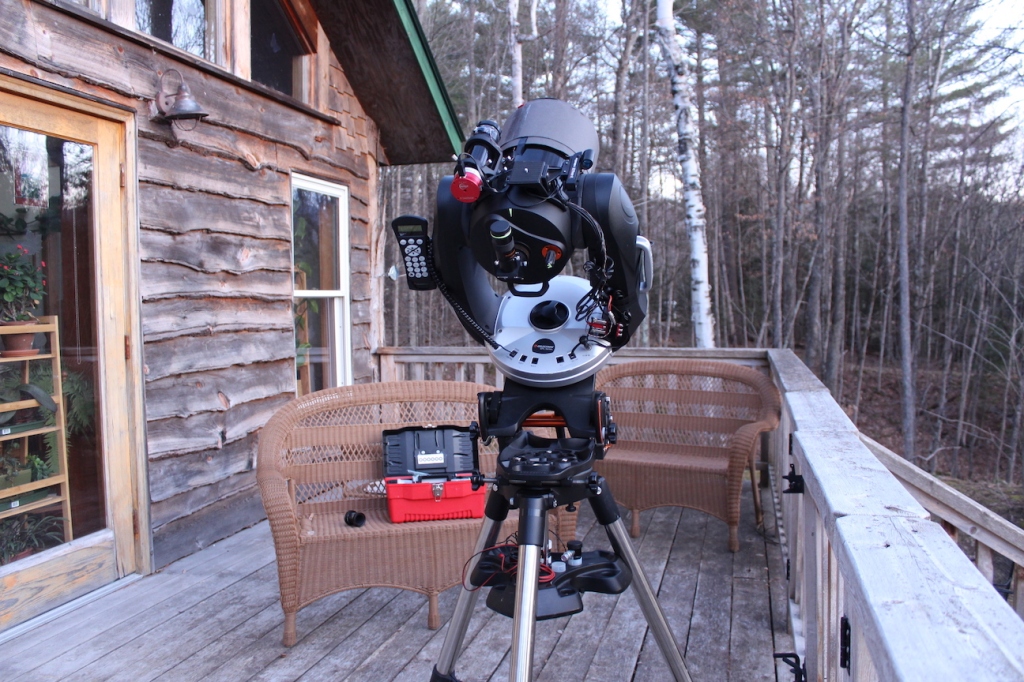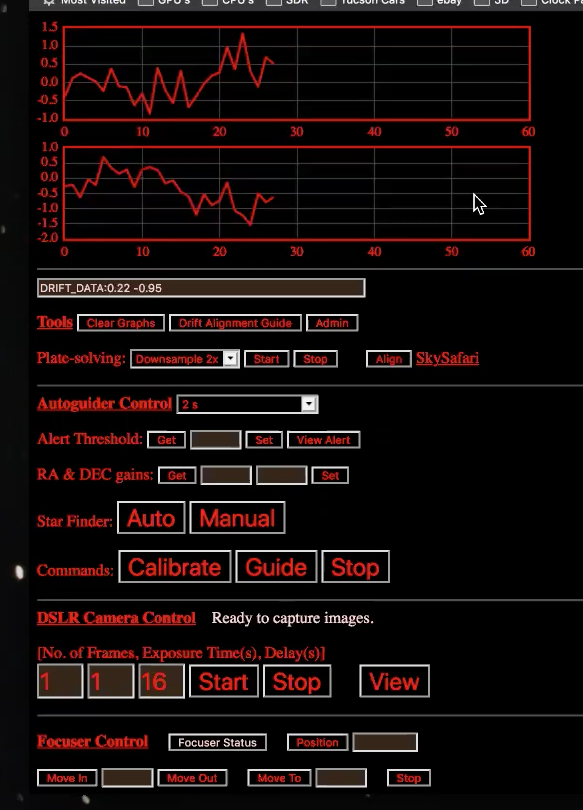Another cold winter and now Covid-19! Yikes!
But the stargazing itch finally reached overwhelming proportions and news of the comet C/2019 Y4 (Atlas) flareup was – enticing.
‘Twas March 27th with a clear-sky forecast and rain thereafter. That meant there was just no choice. I had to go out and take look. And I really wanted some company! But darned that Covid-19!
From the microscopic to telescopic…I decided to move operations to the back deck. A strict no-no! Oh well, I did it anyway. Even a solidly constructed deck does not a stable astronomy platform make. But the deck is convenient and close to my home WiFi network – a necessity for sharing. I gave it a try.

Covid-19? No more outreach? Ah phooey!
But how to invite neighbors to join me? Zoom teleconferencing, of course!
I used Zoom to share the computer screen in real-time while pointing the scope, setting up the auto-guider, and taking exposures. Now that’s what I call outreach! And it was thrilling to have my friends from far off regions join in!
It turns out that little Covid bugger was keeping me confined, but was a great motivator – spurring me on to try something new. A virtual stargazing party! We’re safe, reasonably happy, and stargazing together…without leaving our homes!
So from my bouncy deck and shrouded by trees, my backyard became a temporary and virtually impromptu observatory. About 12-15 or so attendees – I loved that there was still interest and I loved seeing my friends, if only virtually.
Here are a couple of screen shots:


Initial views weren’t great. And – it was my friend from Tucson who first spotted the smudgy smudge that was C/2019 Y4 (Atlas). Thanks Mike!
My alignment was off, despite aligning the scope beforehand. It was tough finding the usual alignment stars through tree branches. The house blocked the entire eastern sky. I had a view of Sirius through branches to the south and Venus to the west. These are the objects I initially aligned to. I did the best I could.
Anyway, after entering the right ascension/declination coordinates into the telescope…it dutifully slewed to arrive at what you see above. A few attempted 2 to 3 minute exposures finally coaxed the comet into emerging – barely in frame. No matter, it was there!
As so often happens, the decent images didn’t come until after everyone left. I went out and refocused the scope, used the often forgotten “precise GOTO” feature of the CPC-800. It was just dandy in this case. It got the comet nearly dead-on. (Precise GOTO slews the scope to the nearest bright star. Then you re-center the star. The CPC-800 remembers the offset required to do that, and applies the offset as a correction upon returning to the desired coordinates of the comet. Pretty darned slick!)
I re-calibrated the auto-guider. Everything was set. Then the decent 5 minute exposures started coming in. It was at about 11:00 that I decided to go to bed and let the Raspberry Pi do my bidding, taking exposures well into the morning hours. Five hours worth.
Thanks to FiJi, ffmpeg, and apngasm (open-source software) and my good old 2011 iMac!, here’s a time-lapse video of the comet in motion. It’s a series of 5-minute exposures at ISO 3200 from my Canon T5i camera.
And note the bonus dwarf galaxy, UGC 4326 in the upper-right corner! This is a 13.8 magnitude galaxy and it’s about 225 million light-years away. That’s about all I know of it. It was quite unexpected.
Look carefully – there are some cosmic-ray hits that excited the sensor in a few frames; I left them in, for they’re extraterrestrial photons too! There’s also a satellite that drifted through one of the later frames. It only takes one billionaire to launch thousands of satellites and ruin the night sky for everyone (don’t get me started!)
Notice the tail is forming and clearly pointing in a direction that is not on the comets trajectory. Its always an interesting thing to see. This will be fun to monitor as we approach the comets predicted peak in May.
Thanks for reading, and keep looking up!
Update: As of early April, It’s said that this comet is breaking up! Yikes! I’ll be taking another look. I’m glad I caught it before hand.

Good show–great glad I got things fixed in time!-we had a bit of social talk when you were on the porch adjusting things—my friends had a gathering on zoom in Colorado –looks like this my be the way of things in this trying times –at any rate lots of fun lets do it again soon!-thanks 73s -M
LikeLiked by 1 person
Thanks Mike! We’ll do it again!
LikeLike
So cool! Can you explain why the axis of the tail is not in the direction of motion? Wouldn’t we expect the comment to move towards the sun with the solar wind causing the particles to stream behind it?
LikeLike
So cool, David! Can you explain why the axis of movement is different than the axis of the tail? Wouldn’t we expect the comet to be moving towards the sun so the solar wind pushes the tail behind it?
LikeLike
The comet follows a trajectory through the solar system heading around the sun, and the tail is blowing away from the sun. But we see the progression of the comet from our position. It’s perspective will change from our viewpoint as the comet (and we) move.
Go to this page: https://theskylive.com/c2019y4-info and scroll down. You’ll see an interactive view of the orbits. It will make visualizing this easy! Have fun!
…Dave
LikeLike
That orbit view is so cool! It makes it very intuitive to see why the tail isn’t in the same axis as the motion of the comet. Thank you, David!
LikeLike
Very cool website – makes it very easy to see why the tail is not in the same axis as the motion of the comet. Cool!
LikeLike
Very cool Dave. Thanks so much for sharing!
LikeLike
Awesome, David ! I’m late seeing this but am behind in catching up on emails. xo Judy
LikeLike
Thanks for for the nice comments, and thanks for visiting neophyteAstronomer.org! Stay tuned for future virtual stargazing events!
LikeLike